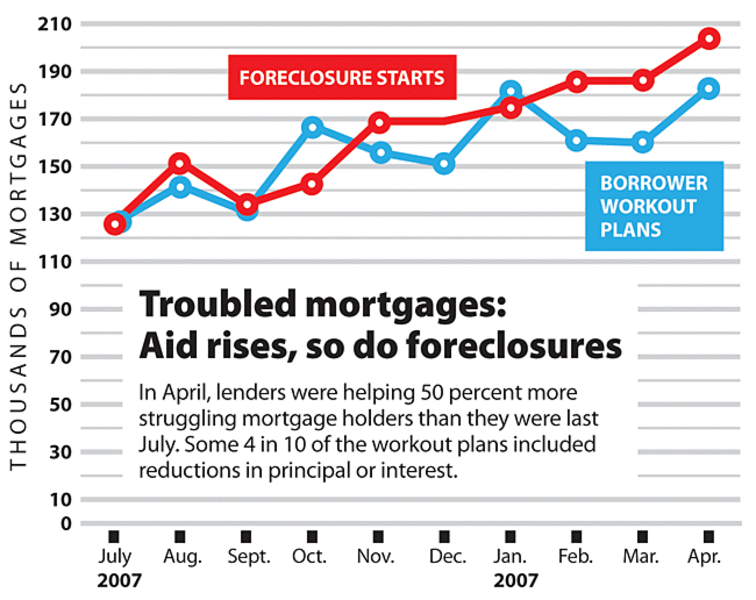New effort to modify at-risk home loans
Loading...
Industry efforts to reduce foreclosures are expanding and improving – a welcome sign of progress in what remains a race to keep up with rising mortgage delinquencies.
The Hope Now Alliance, a group including some of the nation's biggest lenders, announced Tuesday an agreement with mortgage-service companies to modify a greater share of at-risk loans, rather than let them fall into foreclosure.
Among other things, the new guidelines are designed to ensure that participating companies move quickly – deciding within 45 days whether they can modify a loan.
Also, Hope Now said it was launching the mortgage lending industry's first-ever guidelines for dealing with second mortgages. Often, it's been hard to offer relief on the terms of mortgages because many borrowers owe money to two mortgage holders with different interests in "workout" negotiations.
Housing analysts say that, although a full recovery in the housing market won't come with any overnight agreement, the moves by lenders represent a significant step forward.
"Any kind of improvements they can make are ... important," says Ren Essene, a housing market expert at the Joint Center for Housing Studies in Cambridge, Mass. "Clearly they're trying to respond just in time ... as they're learning on the ground what kinds of barriers the borrowers are meeting."
By cutting the number of foreclosures, the new steps could reduce the blight of hard-hit neighborhoods, especially in states such as Florida and California where the problems are most concentrated. And, by reducing the number of fire-sale home auctions, downward pressure on home prices could ease.
This new relief effort comes none too soon. The national foreclosure rate has been rising to record levels, and the upward trend has not abated.
The problems have been concentrated in the so-called subprime loans, but defaults have been rising in prime loans as well. And for one risky class of loans – adjustable-rate mortgages (ARMs) in which the borrower has the option to pay none of the principal balance at the start of the loan – a wave of loan adjustments or "resets" looms in the coming year and beyond.
"These new guidelines will greatly expedite the process of preventing foreclosures," Faith Schwartz, executive director of Hope Now, said in a statement Tuesday.
Hope Now members account for roughly two-thirds of US mortgages.
For the first time, the new guidelines establish a common, streamlined timetable that will be used by each participating mortgage servicer when working with a homeowner to prevent a foreclosure, the group says.
The guidelines involve a common set of principles on alternatives such as loan modifications or repayment plans – and the treatment of second-mortgage holders.
In recent months, they have been expanding the number of loan "workouts," but the effort hasn't kept pace with the rising tide of foreclosures. A rising share of the workouts involve "loan modifications," such as a reduction of interest rate or loan balance. Still, these "loan mods" represent less than half of all workouts.
In so-called "piggyback" loans, a borrower owes the most to one primary lender, and a smaller amount on a second mortgage. Together, the two loans may represent 100 percent of the home's purchase price.
"We make an industrywide commitment that second lien mortgages will not stand in the way" of loan workouts, Steve Bartlett, President and CEO of the Financial Services Roundtable, said in a conference call with reporters.
Under the plan, participating lenders who hold second liens will allow loan modifications to move forward under specific new parameters. Those second lenders will not see a reduction in the amount they are owed and will retain their status of second in line to the primary lender, the group said.
Another goal of the new guidelines is to clarify the options available, streamlining discussions and encouraging borrowers who may be reluctant to talk with banks.
"My own view is [that the result] will be at least a 20 percent increase in the number of homeowners assisted," Mr. Bartlett said.
Representatives of Hope Now said their moves complement, rather than compete, with possible legislation in Congress to encourage more loan refinancings guaranteed by the Federal Housing Administration.
Data on the magnitude of the foreclosure crisis – and the efforts to resolve it – are hard to pin down, says Ms. Essene, the analyst in Cambridge.
But according to data gathered by Hope Now, the industry worked with borrowers on 183,000 loan workouts in April, up from 151,000 last December.
But the effort hasn't kept pace with the number of loans entering foreclosure, which rose to 204,000 in April, the group says.
A rising share of the workouts involve a reduction of interest rate or loan balance. Still, such loan modifications represent less than half of all workouts.
Repayment plans, still the bulk of workouts as of April, leave a high risk of foreclosure.
That leaves the question of whether additional policy efforts may be needed to deal with the housing crunch.
"Congress could do more," and may need to do more, Essene says.





